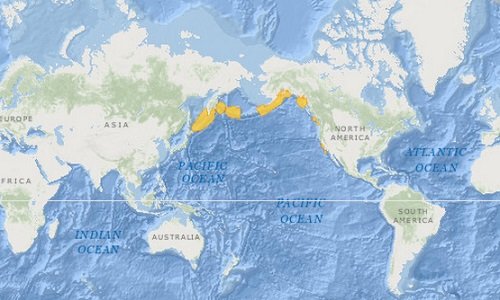
Sea otters are like the fuzzy guardians of the kelp forests, playing a crucial role in maintaining the health of their environment. They are primarily found in coastal areas, but their exact locations can vary. A bit like a cozy blanket, their habitat wraps around certain regions of the Pacific Ocean. So, let’s dive deeper into where sea otters live and uncover the details about their homes.
Sea Otter Habitat Overview
When we talk about sea otter habitats, think of them as the perfect blend of comfort and functionality. These furry critters prefer shallow coastal waters where they can easily access their favorite foods, like sea urchins, crabs, and fish. You might be surprised to learn that they often hang out in kelp forests. These underwater forests provide shelter and nursery areas for many marine species—and a fantastic playground for sea otters.
Typically, sea otters can be found in waters ranging from 3 to 100 feet deep. They’re not too picky, but they do favor temperate coastal regions. This makes sense when you consider that warmer waters provide a rich supply of food while also keeping them cozy. They can be spotted from Alaska all the way down to California, showing just how adaptable they are to various environments.
Despite their love for the water, sea otters need land too. They often haul out on rocky shores or beaches to rest, groom, and care for their young. Just imagine them lounging on a sun-drenched rock, popping their heads out of the water to enjoy the sunshine—it’s a pretty idyllic life!
Kelp Forests: The Sea Otter’s Playground
Kelp forests are the ultimate playground for sea otters. They provide not just food, but also protection from predators. These underwater plants grow tall and dense, creating a canopy where otters can hunt for food while staying safe. When you think about it, it’s kind of like having a built-in restaurant and a cozy home all in one!
Kelp forests help keep the ecosystem balanced too. Sea otters play a crucial role by eating sea urchins, which can otherwise overpopulate and damage the kelp. Without otters, we could see some serious ecological consequences, like barren underwater landscapes. So really, they’re doing more than just looking cute; they’re working hard to keep their world in check!
Geographic Distribution of Sea Otters
Now that we’ve painted a picture of their habitat, let’s take a look at where you can find sea otters geographically. Their range primarily covers the western coast of North America. The largest populations are located in Alaska, where you’ll find them bustling in the clear, cold waters. They’ve also made a comeback in California, especially along the central coast, where conservation efforts have helped increase their numbers.
Interestingly, sea otters are also present in parts of Russia and Japan. However, their populations in these areas are lesser-known compared to North America. In Alaska, sea otters have managed to reclaim their habitats, while in California, they are still recovering from past overhunting and habitat loss.
If you ever find yourself in these coastal regions, keep an eye out for sea otters. You might just spot them floating on their backs, using tools like rocks to crack open shellfish. It’s a sight that can make anyone’s day a little brighter!
Climate and Environmental Factors
The climate is another critical factor that influences where sea otters live. They generally prefer cooler waters, which are often rich in nutrients. Warmer temperatures can lead to a decline in kelp, making it harder for them to find food. This is significant because sea otters have a high metabolism and need to consume about 25% of their body weight daily just to stay warm and energized.
Additionally, pollution and habitat degradation can also impact their distribution. Areas that have clean water and healthy coastal ecosystems are where you’ll typically find thriving sea otter populations. Conservation efforts play a vital role in ensuring that these habitats remain intact, allowing sea otters to continue their playful existence.
Conservation Status and Challenges
Sadly, sea otters face various challenges that threaten their habitat and distribution. While their populations are recovering in some areas, they still encounter dangers, such as oil spills, fishing bycatch, and habitat loss. You might be wondering, “What does all this mean for sea otters?” Well, a healthy otter population is essential for a balanced ecosystem.
Organizations and agencies are actively working to protect their habitats and reduce human impacts. This includes stronger regulations on pollution and promoting sustainable fishing practices. So, when we think about where sea otters live, it’s also important to consider how we can help protect those places.
What Can We Do to Help?
You don’t need to be a marine biologist to help sea otters. Simple actions, like reducing plastic use, can make a big difference. Participating in beach clean-ups helps keep our oceans clean and safe for all marine life. Plus, supporting local or global conservation efforts can aid in preserving the habitats that sea otters rely on.
It’s about taking small steps that, when added together, create huge waves of change. If we can keep their homes safe and healthy, future generations will have the chance to enjoy the presence of these charming creatures.
Final Thoughts on Sea Otter Habitat
In conclusion, sea otters are fascinating animals that thrive in specific coastal habitats. They prefer shallow, nutrient-rich waters in kelp forests, where they find food and protection. Their geographical distribution spans from Alaska to California, with efforts being made to help them recover in areas where their populations were once depleted.
Understanding where sea otters live isn’t just an academic exercise; it helps us appreciate their role in the ecosystem and emphasizes the importance of protecting their environment. So, next time you think of sea otters, picture those lush kelp forests and the delicate balance of life they represent. Together, we can ensure that these delightful creatures continue to thrive for generations to come.
